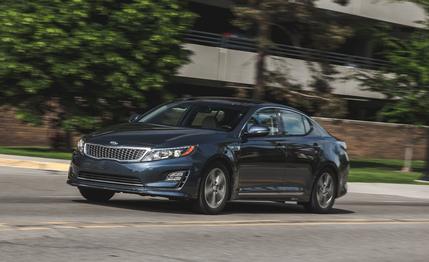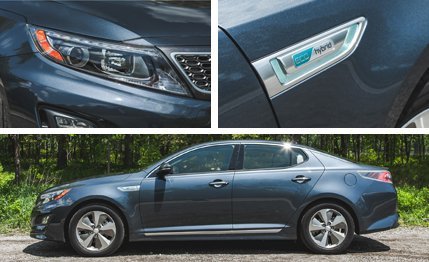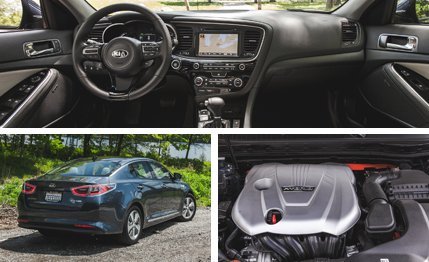
 Instrumented Test
Instrumented Test
The current Kia Optima sedan has been a runaway success for the brand, changing hearts and minds from Oregon to Orlando with its sleek styling, spacious and well-made interior, and, of course, killer warranty since the model first appeared in 2010. And we’ve generally liked it around here, too—except in hybrid form, which suffered from drivability issues that not even that handsome face could overcome.
In 2013, the powertrain received some much needed attention to address those drive-quality concerns. It also added some much needed power (up to 199 total horsepower and 235 lb-ft of torque) and one or two more mpg in fuel efficiency. That was followed by a mild face lift for 2014 that gave it new LED running lights and taillamps, unique grille and fog-lamp treatments, and, according to Kia, slightly improved aerodynamics.
So we figured we’d give the Optima hybrid a second chance to make a first impression and see if the enhancements would bring the driving experience up to the level of proficiency that characterizes most of the rest of the car. Here’s what we learned. On the track, the Optibrid’s 0-to-60 run of 8.1 seconds and quarter-mile time of 16.3 seconds at 88 mph are exactly the same as those posted by the mechanically identical 2013 Hyundai Sonata hybrid. (Compared with the 2011 Sonata hybrid, the twin to the 2011 Optima hybrid, they are 1.4 seconds and 0.8 second faster.) Those aren’t barnstorming numbers but still practical improvements. Our 32-mpg observed fuel economy over many hundreds of miles driven is also respectable, considering our collective lead foot, if a few pegs shy of the EPA-rated 35 mpg city and 39 mpg highway. That’s the good news.


Devil in the Details
But—cue the sad trombones!—the Optima’s around-town drivability issues persist. The 2.4-liter Atkinson-cycle four-cylinder engine prefers to stay dormant as much as possible, allowing the electric motor to do much of the pulling around town—great for being an eco dork but not so great when, say, you’re making a perpendicular crossing of a busy two-lane road and the indecisive computer takes valuable 10ths of a second to register your aggressive right foot, at which point it refires the engine and you get all the power. Hello, whiplash, pissed wife, and wakey baby.
Stopping isn’t much more graceful. The 186-foot 70-to-0 stopping distance is on the longish side, and the brake pedal is very touchy—like, “bang your head into the wheel” touchy, according to executive online editor Erik Johnson, who added the caveat that after the first few stops, it was “adjusted to.” The rest of us never quite mastered it, especially wearing dress shoes or any other footwear less sensitive than racing shoes, which might allow the driver to feel the little feedback the brake pedal offers. One reckons you should be able to execute limo stops while dressed like a limo driver, not Mario Andretti.
Roadholding is likewise disappointing as the Optima EX hybrid pulls a mere 0.78 g on the skidpad, accompanied by spectacular understeer. Our test driver described the steering as “soulless” and noted its artificial return-to-center behavior. At least the ride quality is generally good, and at freeway speeds, the cabin is Lexus quiet.


Then there’s the unavoidable matter of limited trunk space, endemic to all hybrid family sedans. Even though the new lithium-polymer battery pack is more potent and smaller than the previous hybrid’s pack, it still eats up a huge amount of the Optima’s trunk space—4.6 cubic feet, to be exact—leaving the car with 10.8 cubes, nearly three fewer cubic feet than in the trunk of a Kia Rio sedan, so pack light.
Or you can stash bigger items inside the Optima’s spacious interior, which offers plenty of room for a family of four (even with two in child seats), a wow-inducing design, and when the $1500 panoramic sunroof is ordered, puh-lenty of light. There’s perhaps a bit of overreliance on piano black trim, but the stitched, padded dashboard and huge touch-screen infotainment display more than make up for it.
However improved it might be over the first model, we expected the 2014 Optima hybrid’s powertrain, steering, and brakes to be better executed this time around. Especially when the rest of the car is so good.